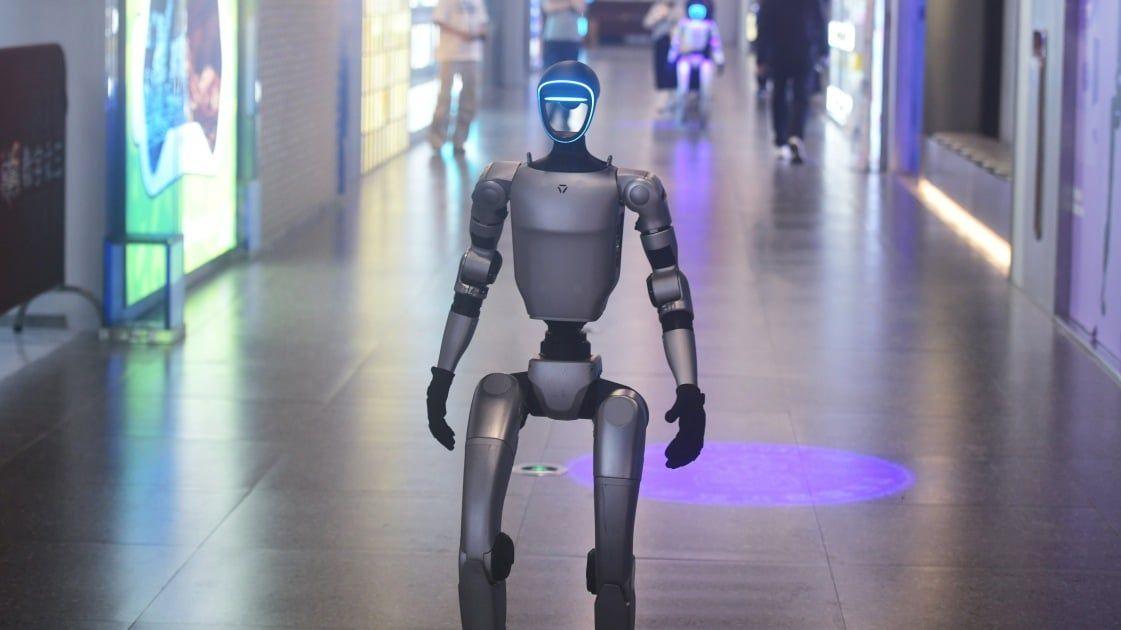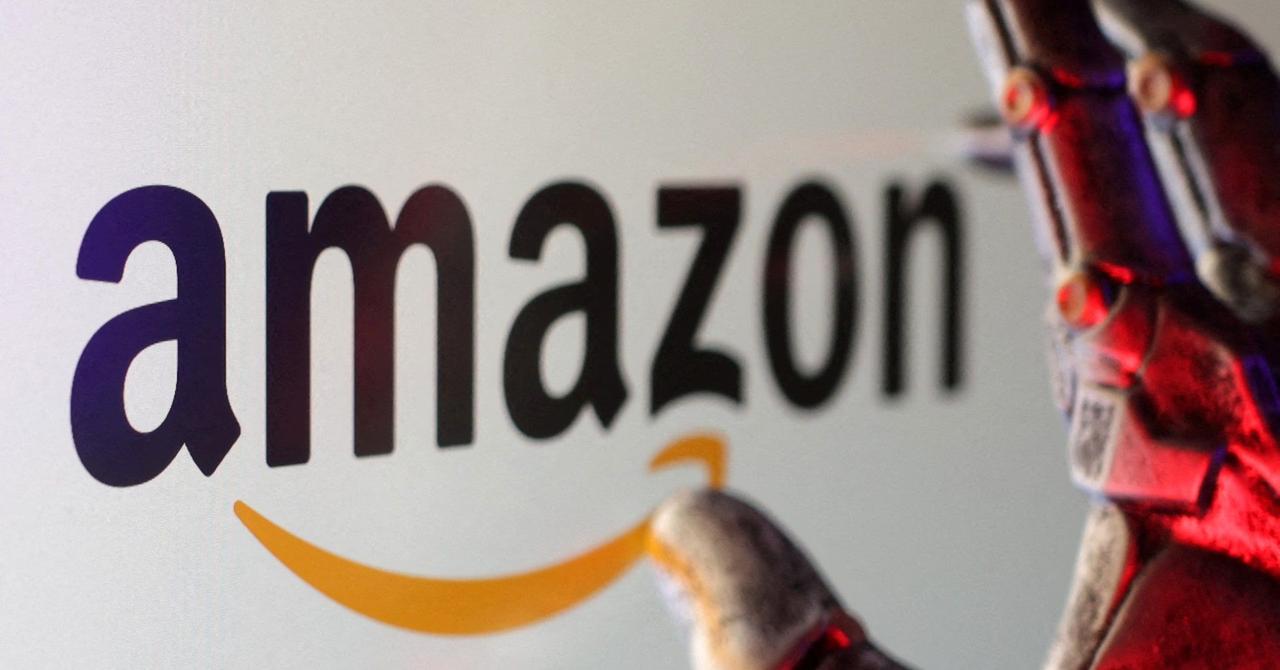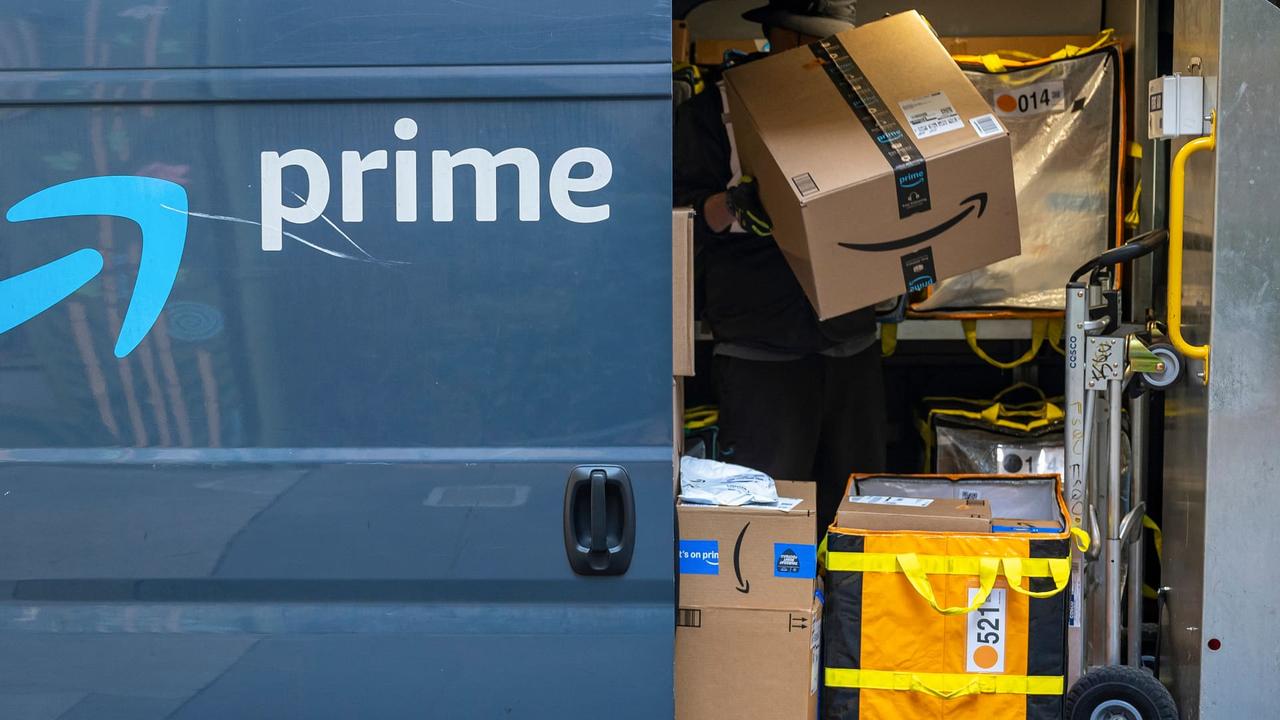Amazon's Humanoid Robots: The Future of Package Delivery
13 Sources
13 Sources
[1]
Amazon's Building Humanoid Robots to Speed Deliveries to You
Amazon is reportedly testing package-delivery bots in one of its facilities. Will they talk to your Ring doorbell? Amazon has used drones to deliver packages, but according to an internal report cited by The Information, the retailers is planning to test out more human-like autonomous delivery methods. Namely, robots that would walk right up to your door to deliver items. The company is reportedly finishing work on a San Francisco-based obstacle park to work on the technology. It's unclear how soon the technology might be developed or used for real-world deliveries. Amazon has been touting its work in robotics for the home and for warehouse work, but this is the first time the company has made an explicit push into using human-like robotics for package delivery, which could replace human workers. The robots would use some of the same AI technology that the company is rolling across other areas of its business. Along with delivery robots, Amazon is working on humanoid robots that would work in its warehouses, according to Reuters, reporting on an event at Amazon's Lab126 research facility. In a post on its X account, Amazon pointed to a story about how it's using agentic AI across several fronts: "We're developing foundation models that will allow fulfillment center robots to understand and act on natural language commands. Imagine saying 'Pick up that yellow tote' and having a robot do it instantly. The future of robotics is here, and it speaks your language." The company has hundreds of robotics-related job listings posted in the US, Canada, Germany and Luxembourg. Amazon did not immediately respond to a request for information.
[2]
Honey, the Amazon humanoid delivery robot is here! (well, almost)
If Amazon has its way in the future, you might see a humanoid robot jogging to your door to deliver packages. According to a report from The Information (citing an insider source) that was later shared by other media outlets, Amazon is working on software for human-like robots that would allow the robots to deliver packages. Also: Why I recommend this Amazon Fire TV soundbar to most people - especially at this new low price The report noted that these robots would "hitch a ride in the back of Amazon's electric Rivian vans" (Amazon says there are currently more than 20,000 of the custom-designed electric vans in service) and "spring out to deliver packages." Since Amazon's Rivian vans are still human-driven (for now), this seems to indicate that the robots are counterparts to a human driver instead of a replacement. Perhaps it will be a situation where the van parks, and the robot (or multiple robots) makes some deliveries while the human driver makes others. Real-world testing should begin soon, as Amazon is nearing completion of a "humanoid park" indoor obstacle course at its San Francisco offices, where it will put its robots through various trials much like we've seen with Boston Dynamics. It doesn't seem that Amazon is developing the actual robots just yet, as The Information said the company will test a variety of robots, including the G1 from Unitree, which comes with a price tag of $16,000. Also: Slow Fire TV? This 30-second fix made my system run like new again This report comes just a day after Amazon announced a number of AI-centered innovations, including an AI foundation model framework that lets robots understand natural language commands and even follow multiple commands at once. The company already uses more than 750,000 robots around its warehouses to assist its workers. It tested Scout, a six-wheeled, autonomous delivery robot, for several years in California until the project was shelved in 2023. Also: I tested a robot mower with no boundary wire - here's who it's perfect for I've reached out to Amazon for an update. Get the morning's top stories in your inbox each day with our Tech Today newsletter.
[3]
Amazon humanoid delivery robots are coming
If Amazon has its way in the future, you might see a humanoid robot jogging to your door to deliver packages. According to a report from The Information (citing an insider source) that was later shared by other media outlets, Amazon is working on software for human-like robots that would allow the robots to deliver packages. Also: Why I recommend this Amazon Fire TV soundbar to most people - especially at this new low price The report noted that these robots would "hitch a ride in the back of Amazon's electric Rivian vans" (Amazon says there are currently more than 20,000 of the custom-designed electric vans in service) and "spring out to deliver packages." Since Amazon's Rivian vans are still human-driven (for now), this seems to indicate that the robots are counterparts to a human driver instead of a replacement. Perhaps it will be a situation where the van parks, and the robot (or multiple robots) makes some deliveries while the human driver makes others. Real-world testing should begin soon, as Amazon is nearing completion of a "humanoid park" indoor obstacle course at its San Francisco offices, where it will put its robots through various trials much like we've seen with Boston Dynamics. It doesn't seem that Amazon is developing the actual robots just yet, as The Information said the company will test a variety of robots, including the G1 from Unitree, which comes with a price tag of $16,000. Also: Slow Fire TV? This 30-second fix made my system run like new again This report comes just a day after Amazon announced a number of AI-centered innovations, including an AI foundation model framework that lets robots understand natural language commands and even follow multiple commands at once. The company already uses more than 750,000 robots around its warehouses to assist its workers. It tested Scout, a six-wheeled, autonomous delivery robot, for several years in California until the project was shelved in 2023. Also: I tested a robot mower with no boundary wire - here's who it's perfect for I've reached out to Amazon for an update. Get the morning's top stories in your inbox each day with our Tech Today newsletter.
[4]
Amazon Is Prepping for a Future Where Robots Replace Human Delivery Drivers
We might not be far away from the day when Amazon packages get delivered by a robot. The e-commerce giant is currently working on software for humanoid robots ahead of planned testing at a dedicated "humanoid park" at one of its San Francisco facilities, The Information reports, citing a person familiar with the development. The park will have an indoor obstacle course, and Amazon hopes the humanoid robots will be able to hop on the back of a Rivian electric van and step out to complete deliveries. The company will be testing robots offered by several companies, including those from the Chinese firm Unitree (image above). As for the vehicles, Electrek reports that Amazon's delivery fleet currently has 20,000 Rivian electric vans; that number is expected to hit 100,000 by 2030. Amazon previously tested humanoid robots in a warehouse in Seattle in 2023. Called Digits, these robots could lift objects like humans and assist them with certain repetitive tasks, such as tote recycling. The new project, though in its infancy, is about humanoids delivering packages. The report follows Amazon's announcement of a new agentic AI team, which will, among other things, focus on developing the AI framework for its robotics operations. It's not the first time Amazon has tried to replace human delivery staff with robots. Its Prime Air service uses drones to drop packages in eligible areas. It recently started delivering gadgets like iPhones, AirPods, and Galaxy phones in under 60 minutes.
[5]
Amazon prepares to test humanoid robots for deliveries, The Information reports
June 4 (Reuters) - Amazon (AMZN.O), opens new tab is developing software for humanoid robots that could eventually take the jobs of delivery workers, The Information reported on Wednesday, citing a person familiar with the matter. Reuters could not immediately confirm the report. Amazon is completing construction of a "humanoid park," an indoor obstacle course at one of the company's San Francisco, California offices, where it will soon test such robots, the report added. The company is developing the artificial intelligence software that would power such robots, the report said, adding that Amazon plans to use hardware from other firms in its tests, for now. Amazon did not immediately respond to a request for a comment outside its regular business hours. In a series of announcements on Wednesday, Amazon demonstrated how stockroom robots, delivery people and its sprawling warehouses will all benefit from a hefty dose of AI, speeding packages to customer doorsteps. Reporting by Gursimran Kaur in Bengaluru; Editing by Rashmi Aich Our Standards: The Thomson Reuters Trust Principles., opens new tab Suggested Topics:Artificial Intelligence
[6]
Amazon sets sights on humanoid robots for last-mile delivery
Serving tech enthusiasts for over 25 years. TechSpot means tech analysis and advice you can trust. Something to look forward to: Amazon's ongoing investment in robotics and AI suggests the company sees automation as a key part of its future. Now, it is experimenting with humanoid robots in its delivery operations, an initiative that could fundamentally reshape how packages reach their final destination and potentially transform the nature of delivery work itself. According to a report from The Information, the e-commerce giant is developing artificial intelligence software to power these robots and has nearly completed an indoor testing facility - dubbed the "humanoid park" - at its San Francisco offices. The facility is designed to simulate the unpredictable challenges of real-world deliveries, featuring mock doorways, stairs, and even a Rivian electric delivery van for practice runs. The initiative aims to create a robotic workforce capable of handling the so-called "last mile" of delivery, a task currently managed by hundreds of thousands of human workers worldwide. For now, Amazon is relying on hardware from third-party manufacturers, including a $16,000 humanoid robot from the Chinese company Unitree, while it focuses on refining the AI that will allow these machines to navigate complex delivery routes. The company's experience with robots has so far been mostly limited to its warehouses, where purpose-built machines assist with sorting and moving goods. In 2023, Amazon began a pilot with Agility Robotics' "Digit," a humanoid robot designed for logistics tasks, though those trials have remained within the controlled environment of its distribution centers. The new "humanoid park" marks Amazon's first concerted effort to train robots for the unpredictable environments found outside its warehouses. According to sources cited by The Information, the goal is for these robots to "hitch a ride" in the back of Amazon's Rivian electric delivery vans - more than 20,000 of which are already in service across the US - and then spring out to deliver packages directly to customers' doorsteps. In the future, these robots could even work alongside human drivers, potentially speeding up deliveries by allowing both to serve different addresses simultaneously. This push for automation is part of Amazon's broader strategy to integrate advanced AI throughout its logistics network. The company recently announced the formation of a new "agentic AI" team within its secretive Lab126 research and development division. The team is tasked with building systems that enable robots to understand and respond to natural language commands. "Rather than employing inflexible, specialized robots, we are developing systems that can perceive, comprehend, and respond to natural language directives, transforming warehouse robots into versatile, multi-skilled aides," Amazon said in a statement to Silicon Valley. The hope is that these advancements will not only accelerate deliveries but also reduce the physical demands on human workers. Amazon's ambitions extend beyond humanoid robots. Its 2020 acquisition of autonomous vehicle startup Zoox signals a long-term vision of fully automating the delivery process from warehouse to doorstep. However, significant technical challenges remain, especially as robots move beyond controlled environments and into real-world neighborhoods, where obstacles such as pets, children, and irregular layouts can present major hurdles.
[7]
Amazon Looks to Replace Pesky Paid Workers With Humanoid Bots That Don't Need to Pee
The company that brought you workers forced to pee in a bottle is now bringing you robots that don't have to do that. Amazon is pretty serious about robots, and for a long time now, its factories have been teeming with them. Big squat ones, tall crane-like ones, and some big slug boys. It's like the e-commerce, capitalistic version of a George Lucas droid ecosystem with somehow worse naming conventions (I'm looking at you, Xanthus). While those bots are hard at work automating warehouses around the country, there's still one part of Amazon's draconian business that hasn't been irrevocably touched by the cold steel hand of robotic automation, and that's package deliveryâ€"at least for now. According to The Information, Amazon is ready to take the next step in its quest to automate the final step of package fulfillment with a fleet of humanoid robots. The report, which cites an anonymous source involved in the effort, says that Amazon will test the humanoid robots at an indoor park in San Francisco that's the size of a coffee shop. Those humanoid robots are reportedly being trained to "spring out" of Amazon's Rivian-made delivery vans for last-mile package delivery and actually drop the package at your doorstep. Apologies in advance to your dog and its already sour relationship with delivery guys. Since it's 2025, that effort to bring humanoid robots into the delivery fold is being coupled with internal attempts to craft AI software that's designed to operate the bots and guide them to your door. To me, that effort feels maybe a little ambitious considering Amazon hasn't even fully rolled out its LLM-powered Alexa+ voice assistant yet, but hey, never underestimate the appeal of automating the workforce. And naturally, since this is Amazon we're talking about, that's what this is all about. In case you weren't already aware, Amazon has a slightly strained relationship with its labor force, and this is another step toward eliminating that perceived nuisance altogether. A robot, after all, probably isn't being coded to form a union, and it certainly won't have to pee in a bottle after being forced to remain on the factory floor for too long. As much as I love the idea of humanoid robots and the pie-in-the-sky vision of our Jetsons-esque future, I can't help but feel like humanoid robots, in this case, won't really benefit anyone but Amazon in the end. I don't know about you, but I'm not exactly itching for a robot that gets confused about whether to deliver a package on the steps outside my apartment building or in the much safer foyer. We'll see if Amazon can really pull the whole robots delivering your latest impulse purchase thing off, though. There are still lots of hurdles before humanoid robots can really handle the stress of walking on two legs, or God forbid, carrying something with real weight. There's obviously no timeline on when or if robots like Digit, which is made by Agility Robotics, a company that's already partnered with Amazon on humanoid robots, will find their way to real-life applications. Digit is currently being tested in Amazon's factories, but those are much more controlled conditions than, say, the chaotic streets of New York City, where Iâ€"and millions of other peopleâ€"live. Those obstacles won't stop Amazon from trying, that's for sure. Best of luck, Digit, or whatever robot lands this unpaid perma-internship with Amazon; if past employer/employee relationships are any indication, you're going to need it.
[8]
Your Amazon delivery person might soon be a robot, which isn't as terrible as it sounds
Imagine this: a whisper-quiet Rivian EV Amazon delivery truck pulls up to your front door, and before the driver even has a chance to step out, the back of the van briskly rolls up and out jumps a robot carrying a package to your doorstep. It sounds like the stuff of science fiction, but that reality may be closer than we think, according to a new report from The Information, which says Amazon is already running tests. Instead of humanoid robots taking the Amazon delivery crew's jobs, the humanoid robots would work in tandem with the human drivers. The robots would sit silently in the back, and when it's time for package delivery, they'd find the box, open the door, and carefully make their way to your home. Amazon is reportedly running test drives and deliveries in a specially created 'Humanoid Park', which we assume would help recreate some of the obstacles the humanoid robot might encounter, like cars, people, dogs, small wild animals, lawn sprinklers, porch lamps, porch swings... you get the idea. The Information also reports that Amazon might be using large language models (LLMs) to help the humanoid robots deal with what is likely to be a hard-to-predict environment. Houses are not all cookie-cutter, after all. The doors, steps, lawns, and even distances to the front doors are all different. It's unlikely Amazon can program these robots to anticipate every unexpected obstacle, but LLMs can train them to handle a much wider variety without knowing in advance the specifics of each one. There's no mention of the robots talking to Amazon customers, but with Amazon's investment in Anthropic's Claude AI, a chatty Amazon humanoid delivery bot seems possible. As for which robots Amazon might be using, it's already been testing Agility Robotics' Digit in a factory setting. I think it's unlikely, though, that Amazon uses that robot to complete home deliveries. Its odd appearance, which includes bird-like or backwards legs, might be somewhat off-putting for the average Amazon customer. There's a larger issue with this kind of robot. I saw Digit in action at CES 2025 and, while impressive, it was painfully slow at most tasks. If you've ever seen your Amazon delivery person hop out of the truck, jump into the back, dash out with your package, and run to your front steps before capturing a photo for proof of delivery and then racing off to the next house, you know that an Amazon humanoid delivery robot better be fast. There are other humanoid robot options out there from companies like Boston Dynamics and its all-electric Atlas. It's got speed and cartwheeling skills (see above), but there's no timeline for commercial adoption. Unitree G1 can do karate, but it's likely too small to carry larger Amazon packages. According to the Information Report, there's a sense that the hardware may be the easy part, as, once they have the training in place, they can easily transfer it from one version of the Amazon delivery robot to another, ostensibly better one, all while improving that delivery algorithm. I've asked Amazon for comment and will update this story if and when the company responds. Amazon does have some robot delivery experience. It's been using drones (essentially flying robots) to deliver packages since 2022. Those mostly fly smaller packages and then carefully lower them to your backyard before flying off. It's not a service that Amazon offers everywhere. None of this means Amazon's humanoid robots will be delivering packages anytime soon. Testing and development could take years, but if you add in the possibility of future driverless Rivian EVs, the combination of a self-driving car in the front and a ready-to-deliver robot in the back is a potentially cost-efficient combination for Amazon. How delivery personnel and customers might feel about it is another matter.
[9]
Amazon Testing Humanoid Robots to Ride in Vans, Hand-Deliver Packages
Those are the conditions that led the Teamsters to launch the largest labor strike against Amazon in US history just days before Christmas of last year. But as calls grow to stop treating its workers like robots, Amazon has decided to cut out the middle man -- and just use actual robots instead. That seems to be the goal, at least, behind a new robotics facility meant to test humanoid robots in a real-world delivery environment, a development first reported by The Information. Dubbed a "humanoid park," an anonymous source described the site as an indoor obstacle course located at an Amazon facility in San Francisco. The retail giant is seemingly testing bipedal bots to work with its fleet of Rivian electric vans to deliver packages to homes, which were reportedly part of the simulated delivery habitat. At the core of it all -- as with just about anything these days -- is a nebulous commitment to AI. "Amazon has no choice but to build software that will allow it to communicate with and leverage robots," harped Brittain Ladd, a former Amazon executive. "The primary impact of AI is that it accelerates velocity across an enterprise or an ecosystem. This means that Amazon has to be able to work 24/7 365 days per year to meet the increased demand AI will generate." How AI will actually factor into the robotics program is unclear. The company has also recently formed a new hardware research unit, focused on shoehorning "agentic AI" into warehouse robots. Ladd, the bigwig responsible for the company's harebrained "micro-fulfillment" concept, calls AI-powered humanoid robots and autonomous vehicles a "must have for Amazon." But the robots aren't ready to take over just yet. "Will Amazon be able to leverage humanoid robots to make package deliveries anytime soon? No," says Ladd. "A lot of work has to be done first. Is it likely that by 2030 the company will be utilizing robots in conjunction with Rivian vans? Yes, that's certainly possible." In the meantime, the tech company is developing screen-embedded eyeglasses -- again crammed with generative AI, apparently -- to squeeze a little bit more out of delivery workers. Or, as an Amazon official told Reuters, "making it easier for Amazon drivers to find the right delivery spot." That migraine-inducing system is getting an "experimental deployment" after Amazon inked a $36.5 million partnership with Finnish augmented reality company IXI. With all that extra time saved navigating deliveries, maybe Amazon can finally let its workers stop peeing in bottles.
[10]
Amazon Said to Be Preparing to Test Humanoid Robots for Deliveries
Amazon plans to use hardware from other firms in its tests, for now Amazon is developing software for humanoid robots that could eventually take the jobs of delivery workers, The Information reported on Wednesday, citing a person familiar with the matter. Reuters could not immediately confirm the report. Amazon is completing construction of a "humanoid park," an indoor obstacle course at one of the company's San Francisco, California offices, where it will soon test such robots, the report added. The company is developing the Artificial Intelligence (AI) software that would power such robots, the report said, adding that Amazon plans to use hardware from other firms in its tests, for now. Amazon did not immediately respond to a request for a comment outside its regular business hours. In a series of announcements on Wednesday, Amazon demonstrated how stockroom robots, delivery people and its sprawling warehouses will all benefit from a hefty dose of AI, speeding packages to customer doorsteps. © Thomson Reuters 2025
[11]
Amazon prepares to test humanoid robots for deliveries: Report
The company is developing the artificial intelligence software that would power such robots, the report said, adding that Amazon plans to use hardware from other firms in its tests, for now.Amazon is developing software for humanoid robots that could eventually take the jobs of delivery workers, The Information reported on Wednesday, citing a person familiar with the matter. Reuters could not immediately confirm the report. Amazon is completing construction of a "humanoid park," an indoor obstacle course at one of the company's San Francisco, California offices, where it will soon test such robots, the report added. The company is developing the artificial intelligence software that would power such robots, the report said, adding that Amazon plans to use hardware from other firms in its tests, for now. Amazon did not immediately respond to a request for a comment outside its regular business hours. In a series of announcements on Wednesday, Amazon demonstrated how stockroom robots, delivery people and its sprawling warehouses will all benefit from a hefty dose of AI, speeding packages to customer doorsteps.
[12]
Amazon tests humanoid robots as package deliverers
Amazon is reportedly developing a fleet of humanoid robots designed for package delivery. These robots would be transported in electric vans and be able to autonomously exit the vehicle to deliver packages to customers' doorsteps. Test facility in According to The Information, citing an anonymous source familiar with the project, Amazon has nearly completed construction of a special test facility in , US. This "humanoid park," about the size of a coffee shop, has an obstacle course and a van for training purposes. The goal is for these robots to integrate seamlessly into Amazon's existing delivery infrastructure. Robotics technologies This initiative follows Amazon's recent launch of a new agentic AI team focused on developing advanced robotics technologies. These systems are designed to give robots the ability to understand and respond to commands in natural language, becoming versatile assistants that can perform a wide range of tasks within Amazon's distribution and logistics networks. Amazon has already experimented with several autonomous robots in its warehouses, including Agility Robotics' "Digit," a humanoid robot initially intended for package delivery from delivery trucks. The new facility in represents a dedicated effort to realize this original vision. Amazon wants to automate delivery The Information reports that Amazon will test several humanoid robots at the facility, including models such as the Unitree from . This development comes at a time when Amazon continues to explore the automation of its delivery operations. With hundreds of thousands of workers currently involved in package delivery worldwide, Amazon's acquisition of robot taxi company Zoox in 2020 suggests a long-term ambition to fully automate the entire delivery process, from warehouse to door. If you want access to all articles, enjoy our promo temporarily and subscribe here!
[13]
Amazon to soon deliver packages using humanoid robots: Here's what we know
While boosting delivery speed, the tech raises concerns about job displacement and increased energy consumption. Amazon is reportedly preparing to test humanoid robots for parcel delivery. According to a report by The Information, Amazon is training AI-powered machines to walk and move like humans and will soon start real-world testing at a dedicated space referred to internally as a "humanoid park" at one of its San Francisco offices. Roughly the size of a coffee shop, the facility features an obstacle course designed to simulate real-world delivery challenges like stairs and tight walkways. It even features a Rivian electric delivery van, enabling robots to practice loading and unloading goods. The company is developing its AI software in-house while the physical robots are being outsourced. The report also coincides with the launch of Amazon's new "agentic AI" team, which aims to advance robotic systems capable of responding to natural language commands. Recently, the e-commerce giant has said that it is creating flexible assistants that can adapt to dynamic environments, both in warehouses and potentially in public settings. While Amazon has not officially confirmed the testing program, the report suggests that it has already deployed over half a million autonomous robots across its global operations. In a 2024 interview with CNBC, Steve Armato, Amazon's Vice President of Transportation Technology and Services, revealed that AI tools help deliver nearly 60% of Prime orders in the top 60 US cities on the same day or the next. The company started using transformer-based AI models in 2020 to improve demand forecasting and warehouse efficiency. The number of robots in Amazon fulfilment centres more than doubled between 2001 and 2003. Also read: Apple WWDC 2025: iOS 19 may bring visual redesign, smarter Siri, AI powered battery saver and more However, the shift toward AI and robotics has sparked concerns over potential job displacement, as thousands of people currently handle Amazon's delivery operations. Additionally, the company's carbon footprint may also increase due to the high energy demands of large-scale AI systems.
Share
Share
Copy Link
Amazon is developing software for humanoid robots to potentially revolutionize package delivery, with plans to test them in a dedicated "humanoid park" obstacle course.
Amazon's Ambitious Plan for Humanoid Delivery Robots
Amazon, the e-commerce giant, is taking a significant leap into the future of package delivery with its latest initiative: developing software for humanoid robots. This groundbreaking project aims to revolutionize the last-mile delivery process, potentially transforming the way packages reach customers' doorsteps
1
.
Source: ET
The "Humanoid Park" Testing Ground
At the heart of this initiative is the construction of a "humanoid park" – an indoor obstacle course at Amazon's San Francisco office. This facility is designed to put the robots through rigorous trials, similar to those conducted by Boston Dynamics
2
. The obstacle course will simulate real-world delivery scenarios, allowing Amazon to refine the robots' capabilities before deploying them in actual delivery situations.Integration with Existing Infrastructure

Source: TechSpot
The humanoid robots are not intended to replace human drivers entirely but to work alongside them. According to reports, these robots would "hitch a ride in the back of Amazon's electric Rivian vans" and "spring out to deliver packages"
3
. With over 20,000 custom-designed electric Rivian vans already in service, Amazon has a robust infrastructure ready to support this futuristic delivery method.AI and Natural Language Processing
Amazon's recent announcement of AI-centered innovations plays a crucial role in this project. The company has developed an AI foundation model framework that enables robots to understand and follow natural language commands, even executing multiple instructions simultaneously
4
. This advancement could significantly enhance the robots' ability to interact with customers and navigate complex delivery scenarios.Testing Phase and Hardware Considerations
While Amazon is focusing on developing the software for these humanoid robots, it's not yet clear if they will manufacture the hardware themselves. Reports suggest that the company will test various robots, including the G1 from Unitree, which costs around $16,000
5
. This approach allows Amazon to experiment with different hardware options before potentially developing their own.
Source: PC Magazine
Related Stories
Implications for the Workforce and Delivery Industry
The introduction of humanoid delivery robots raises questions about the future of human delivery workers. While Amazon currently employs over 750,000 robots in its warehouses to assist workers, this move towards autonomous delivery could significantly impact the job market in the long term. However, the initial phase seems to position these robots as complementary to human drivers rather than as complete replacements.
Amazon's Track Record in Robotics and AI
This isn't Amazon's first venture into automated delivery systems. The company previously tested Scout, a six-wheeled autonomous delivery robot, in California for several years before shelving the project in 2023. Additionally, Amazon's Prime Air service already uses drones for package delivery in eligible areas, demonstrating the company's commitment to exploring various autonomous delivery methods.
As Amazon continues to push the boundaries of AI and robotics in delivery services, the success of this humanoid robot project could mark a significant milestone in the evolution of e-commerce logistics. While the technology is still in its early stages, it has the potential to dramatically reshape the landscape of package delivery in the coming years.
References
Summarized by
Navi
Related Stories
Amazon Revolutionizes Delivery and Logistics with AI-Powered Innovations
05 Jun 2025•Technology

Amazon's AI-Powered Humanoid Robots: Revolutionizing Delivery and Cutting Costs
07 Jun 2025•Technology

Amazon's Robotics Revolution: Transforming Fulfillment Centers with AI and Automation
12 Oct 2024•Technology








